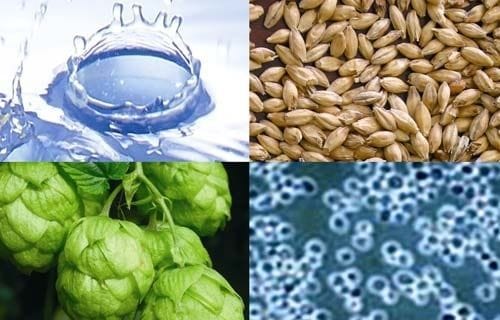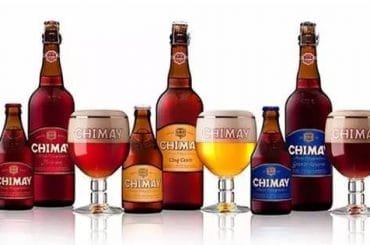This post is also available in:
Español
Português
Marijuana and hops used in beer brewing are genetically “cousins”, as both are members of the Cannabaceae family. These two plants share far more similarities—both physical and chemical—than we commonly believe.

Hops and cannabis develop resinous green flowers that produce organic compounds called “terpenes”, responsible for most of their aromas and flavors. This natural synergy explains why beer and marijuana complement each other so well.
Contenido
Legal Marijuana and Craft Beer
With the rise of legal marijuana and craft beer, there is now a wide variety of options available, thanks to years of innovation and dedication by growers, producers, and consumers seeking to go beyond the ordinary.
In response to the infinite variety of beer styles and cannabis terpene combinations, some references have emerged to guide novice consumers in selecting a marijuana strain that pairs well with each type of beer.
Below, we’ll analyze in detail why beer and marijuana pair so well together and how to match them for optimal results.
What Types of Marijuana Exist?
There are essentially three general varieties of marijuana: Cannabis sativa, Cannabis indica, and Cannabis ruderalis. The latter is less attractive due to its smaller size and low THC concentration.

1. Cannabis sativa
It is a cold-climate species that produces short, dense plants with dark, broad leaves.
Its maturation takes 10 to 15 weeks and is known for its energizing and brain-enhancing qualities, making it ideal for daytime use.
Medically, it is often used to help treat depression and chronic pain.
No se encontraron productos.
2. Cannabis indica
It is a cold-climate species that produces short, dense plants with dark, broad leaves.
Its maturation takes 6 to 8 weeks and generally has a higher yield than Sativa.
It is known for producing deep muscle and mental relaxation, often used to treat nausea, anxiety, and acute pain.
3. Cannabis rudelaris
Cannabis ruderalis is a variety of the cannabis plant found in cold regions of Northern Europe and Asia.
It is a less common variety of cannabis, characterized by its low THC content, but it is used to create auto-flowering hybrids that bloom automatically after a certain time, rather than relying on photoperiodism to induce flowering.
The Diversity of Craft Beer
The flavor of your favorite craft beer is the result of a carefully thought-out combination of ingredients: water, malt, hops, and yeast.

Beer is essentially made through the alcoholic fermentation of a sweet wort obtained from malted cereals (primarily barley), to which hop flowers are added for bitterness and antibacterial properties.
Hops also contain terpenes, many of which are shared with marijuana. Additionally, many brewers today infuse their beers with additives like fruits or barrel aging, adding layers of aroma and flavor.
It’s All About the Terpenes
Terpenes play a crucial role in the aroma and flavor profile of beer due to the addition of hops. In cannabis, they not only affect flavor and aroma but also influence its psychoactive effects.
Cannabis and hops share many terpenes, such as limonene (citrus), pinene (pine), and linalool (floral). This is why similar descriptors are often used for both marijuana and beer: earthy, floral, citrusy, spicy, sour, etc.
Terpenes in cannabis are secreted in the trichomes of the flowers, just like THC and CBD.
How to Pair Beer and Marijuana?
It’s clear that beer and marijuana share a wide range of aromas and flavors, allowing for many interesting combinations. But how do you achieve a good pairing?
Aroma and Flavor
To enhance the nuances of beer without getting lost in subtleties, experts recommend starting with beers with a defined character and marijuana strains famous for their flavor, such as Strawberry Cough or Mango Kush.
Starting this way will allow you to develop more complex combinations over time, after first experimenting with the most basic pairings.

Learning to pair intensely flavored beers with Skunk marijuana strains, for example, may seem like an impossible task, but it’s best to consider it a fun experiment and challenge your taste buds.
If you have specific preferences for beer styles, don’t hesitate to try different cannabis strains with the same beer to discover which works best for you.
The same applies to those who prefer a specific marijuana strain but are open to trying many different types of beer.
2. Alcohol and THC
Two factors to consider when pairing are the alcohol content of your beer and the expected effects of your marijuana strain.
In general, those who do not usually mix alcohol and cannabis should avoid initially experimenting with high-alcohol beers and strains with very high THC levels.
Although beer and marijuana can be very fun when combined, they can also cause unpleasant effects in high doses.
Indicas, for example, known for their pleasant relaxing and sedative effects, are not always the best complement to beer, as alcohol is a depressant with its own sedative qualities. Therefore, you might prefer to opt for a sativa or hybrid marijuana strain.
Recommended Beer and Marijuana Pairings
Below, we share some quick and easy beer and marijuana pairing tips that have stood the test of time and taste, always ensuring a quality experience.
1. Semi-Bitter Beers for Most
A type of beer that always pairs well with most cannabis strains is beer with medium bitterness, such as American Pale Ale or Amber Ale.
With their slightly bitter flavors, these beers offer a more refreshing experience, reducing the dry mouth sensation that heavier and/or hoppier beers, such as Stout or India Pale Ale (IPA), can cause.
2. Pinene and Limonene for IPAs
IPAs are known for their hoppy character and intentional bitterness, but they also have deep flavors that are enhanced by cannabis strains rich in pinene.

A current trend in the IPA segment is the addition of fruity and citrus flavors like grapes and oranges during brewing, which are further amplified when paired with cannabis strains containing limonene.
Two classic sativas that pair perfectly with IPA beers are Jack Herer and Jack The Ripper, with their distinct piney and citrus profiles, respectively.
On the other hand, Skunk varieties are considered the best complements for IPA beers, as they can easily stand up to the bold aromas and flavors of this beer style.
Skunk strains are known for their uplifting and euphoric effects, with a long-lasting daytime high, starting with the classic Skunk #1, followed by Lemon Skunk, Pineapple Skunk, and Skunk 47, all popular crosses that live up to the original.
3. Myrcene for Stout and Porter Beers
Stouts and Porters are two beer styles typically intense in aroma and flavor, featuring roasted, chocolate, and coffee notes. For this reason, when pairing, you should avoid overly sweet and caramelized cannabis strains.
A great option is to pair with the XJ-13 strain, which will keep your mind happy and active, while its sweet-and-sour cannabis profile integrates perfectly with the dark beer’s bitter chocolate notes, and its piney undertones harmonize with the roasted and coffee flavors of Stouts and Porters.
These balanced pairings could be so effective that they might turn Stout and Porter novices into new enthusiasts, teaching them to appreciate the unique qualities these beers have to offer.
4. OG for Sour Beers
Like sour beers, OG strains are often an acquired taste, but once you master their strong aroma and flavor profiles, there’s no turning back.
Sour OG is a cross between the legendary Sour Diesel and OG Kush, two potent cannabis strains that combine the best of both worlds.
Sour OG not only offers the classic sour profile of Sour Diesel but also incorporates OG Kush’s earthy and slightly musty notes, which soften and round out the beer’s fruity, leathery, and damp characteristics typical of sour beers—a combination that will make your head and body buzz.
5. Linalool and Wheat Beers
Wheat beers derive their unique characteristics from the added grain during the brewing process, imparting a distinctive flavor, aroma, and body to the beer.
Wheat beers tend to be smoother and creamier than other beer styles, with some German varieties featuring spicy clove and banana-like fruitiness.
Beers of this type pair exceptionally well with strains like Lavender, a wonderful variety with a unique linalool terpene profile responsible for the floral aroma of cannabis—the perfect pairing for a wide range of wheat beers.
The effects of Lavender are relaxing and cheerful, with lots of laughter, making it ideal for ending a long day with a refreshing wheat beer.
6. Pilsner Beer for Any Occasion
Pilsners are a popular choice primarily due to their drinkability, light flavors, moderate bitterness, and typically low alcohol content.
With this in mind, Pilsners are a great way to try a new strain you haven’t smoked before, as when consumed alongside cannabis, Pilsners refresh and cleanse the palate.
One recommended strain for this pairing is Pineapple Chunk, rich in pineapple aromas and flavors but with enough CBD to help smooth out the experience—a solid and versatile strain overall.
No se encontraron productos.
Pairings by Beer Styles and Cannabis Strains
Thirst-quenching blonde lagers paired with deep and pungent strains like Banana Kush (indica), Chernobyl (hybrid), and Green Crack (sativa).
Clean and refreshing Pale Ales paired with floral and cheerful strains like G13 (indica), Bubble Gum (hybrid), and Lamb’s Bread (sativa).
Sweet and refreshing Amber Ales paired with firm yet softly aromatic strains like Lavender Kush (indica), Orange Kush (hybrid), and Lemon Haze (sativa).
Well-defined IPA beers paired with distinctly spicy strains like Hash Plant (indica), Red Dragon (hybrid), and Super Green Crack (sativa).
Sparkling Belgian and French Ales with light spice paired with floral and pungent strains like Afghan Kush (indica), UK Cheese (hybrid), and Voodoo (sativa).
Slightly caramelized Irish Ales paired with flavorful floral strains like LA Confidential (indica), White Russian (hybrid), and Sour Diesel (sativa).
Rich and malty Barleywines paired with creamy and slightly sweet strains like Tahoe OG (indica), Green Queen (hybrid), and Shaman (sativa).
Robust and full-bodied Scottish Ales paired with flavorful, floral strains like Granddaddy Purple (indica), Blue Cheese (hybrid), and Strawberry (sativa).
Dark lagers with a lightly roasted profile paired with earthy strains like Northern Lights (indica), White Rhino (hybrid), and Super Silver Haze (sativa).
Intense and deep Bocks paired with sweet-profile strains like Vanilla Kush (indica), Girl Scout Cookies (hybrid), and Jack Herer (sativa).
Cannabis-Infused Beers
The wonderful synergy produced by the simultaneous consumption of beer and cannabis is further enhanced with the emergence of cannabis-infused beers.
In case you were wondering, most of these beers do not contain the psychoactive compound THC (although it is possible to brew them with it).
This process imparts the flavor of specific terpenes to the beer, although the new trend in these beers is to use terpenes derived from other plant sources that recreate the characteristics of specific cannabis strains.
(*) The Beer Times™ is an independent digital platform that aims to share quality information about beer and cannabis consumption for educational purposes, promoting responsible and informed opinions. Therefore, its content should not be used as a substitute for the judgment of expert medical authorities, to promote consumption among minors, or to evade compliance with the laws in force in each country.
We recommend
- What is a Cold Chain, and Why is it Important for Maintaining Beer Quality?
- Why Do We Celebrate St. Patrick’s Day? Origin, History, and Traditions







